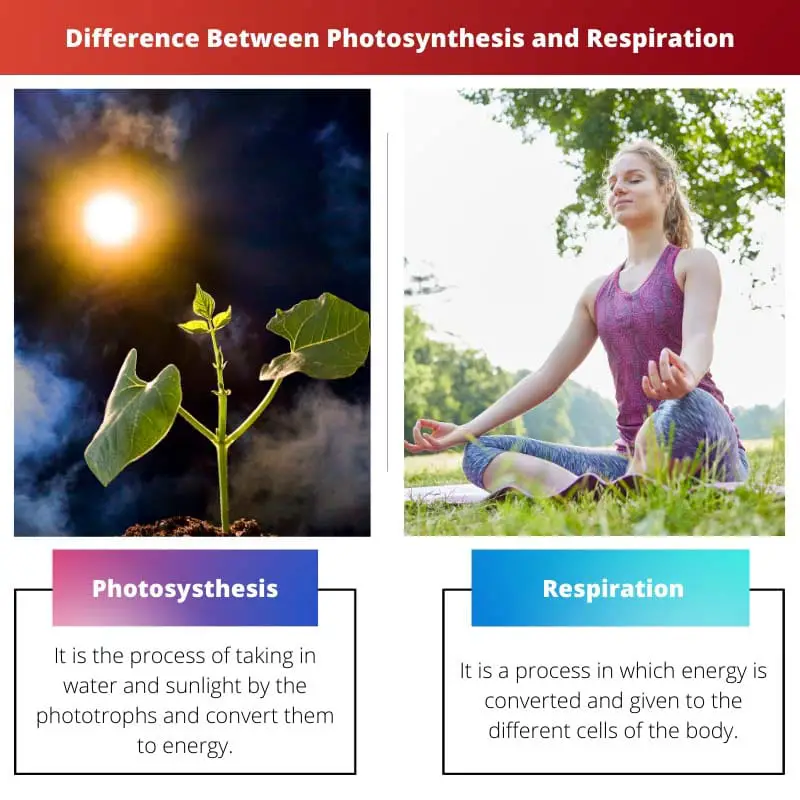Every living organism, whether it’s plants or animals or even bacterias and other small organisms, need energy to survive. Several reactions and functions are taken place internally.
Photosynthesis and Respiration are processes that keep any living organism alive. Photosynthesis occurs in Photographs, whereas Respiration occurs in all living organisms except phototrophs. Both these functions help in survival.
Key Takeaways
- Photosynthesis is a process that converts light energy into chemical energy, whereas respiration is a process that converts chemical energy into usable energy.
- Photosynthesis occurs in the chloroplasts of plant cells, while respiration occurs in the mitochondria of both plant and animal cells.
- The end products of photosynthesis are glucose and oxygen, while the end products of respiration are carbon dioxide, water, and energy.
Photosynthesis vs Respiration
Photosynthesis is the scientific process that occurs when water and sunlight are absorbed by the phototrophs of plants and are then converted to energy. Respiration is the scientific process that occurs in the body when energy is changed and shared across different cells in the body.

Photosynthesis synthesizes complex organic compounds, and it is an anabolic process. They are found in chlorophyllous cells, and this process occurs in Chroloplasts.
This process occurs in sunlight, and chemical energy is stored in the form of carbohydrates. In this process, there is a capturing of energy and synthesizing food. They need sunlight for the process to happen, as it doesn’t happen in the dark.
Respiration is a catabolic process and undergoes exergonic reactions in which there is a release of energy by breaking down food particles. This process involves three steps.
This process occurs in Mitochondria. The by-products of this process are carbon dioxide, water, and energy. It doesn’t require sunlight for the process and happens even in the dark.
Comparison Table
| Parameters of Comparison | Photosynthesis | Respiration |
|---|---|---|
| Definition | It is the process of taking in water and sunlight by the phototrophs and convert them to energy. | It is a process in which energy is converted and given to the different cells of the body. |
| Reactants | The reactants are light energy, water, and carbon dioxide. | For this, the reactants are glucose and oxygen. |
| Reactions | It needs energy thus it is an endothermic process. | It releases energy this is an exergonic reaction. |
| Function | It is an anabolic process that produces food and captures energy. | It is a catabolic process that releases carbon dioxide and takes in oxygen. |
| Presence of Sunlight | It requires the presence of sunlight as it is mandatory for the process to happen. | It happens all the time without sunlight, so not mandatory to have the presence of sunlight. |
What is Photosynthesis?
Photosynthesis is an anabolic process that involves the conversion of light energy into chemical energy. It occurs in chloroplasts and needs sunlight for this process to happen.
It has three steps involved that are light reaction, dark reaction, and photolysis. It results in increased dry weight of the plant. In this process, oxygen is released, and carbon dioxide and water are utilized.
It occurs only in green plants and some bacteria and algae. It undergoes an endothermic reaction, and the by-products are Glucose, oxygen, and water. In this process, the energy is captured in the carbohydrate molecules, and food is synthesized.
In a light reaction, the energy is captured and transferred to electrons which produce ATP, and then there is a reduction of NADPH.
In a dark reaction, with the help of ADP and NADPH, Carbon dioxide is reduced to organic carbon compounds. The rate of the process is 20 minutes more than that of Respiration.

What is Respiration?
A process happens in all the living organisms on the planet except plants and bacteria that enables them to take oxygen from the air and use it in blood and cells.
It haps them to survive by taking oxygen which is an essential nutrient for survival. It is a catabolic process that degrades the compounds. It occurs all the time in the body with or without sunlight.
It involved three steps in the process: Glycolysis, the Citric acid cycle, and the transport chain. The oxygen is taken and utilized, and there is a release of carbon dioxide and water.
It results in loss of dry mass. The energy is released, and some energy is lost in the form of heat. Also, through the oxidation of food, it produces ATP from the liberation of energy.
The whole process occurs in mitochondria, and the rate of the process is lower than the rate of photosynthesis. It is an exergonic reaction, and the chemical reaction of Respiration is C6H12O6 + 6O2 → 6CO2 + 6H2O.

Main Differences Between Photosynthesis and Respiration
- Photosynthesis is an anabolic process in which sunlight and water are converted to energy, whereas Respiration is the catabolic process of breaking down food and releasing energy.
- Photosynthesis occurs in green plants, bacteria, and algae, whereas Respiration occurs in all living organisms except phototypes.
- Photosynthesis occurs in chloroplasts having by-products such as Glucose, oxygen, and water, whereas Respiration occurs in Mitochondria, having by-products like carbon dioxide, water, and energy.
- Photosynthesis is an endothermic reaction that provides food and captures energy, whereas Respiration is an exergonic reaction that takes in oxygen and releases carbon dioxide.
- Photosynthesis absorbs carbon dioxide, and the presence of sunlight is mandatory for the process, whereas Respiration releases carbon dioxide, and there is no need for sunlight as it occurs all the time in the body.




